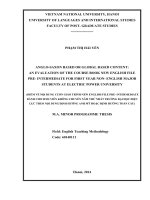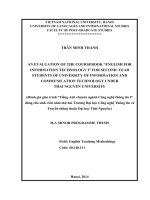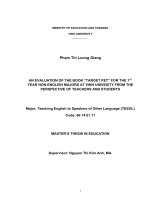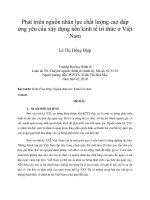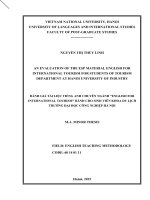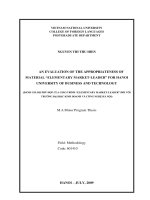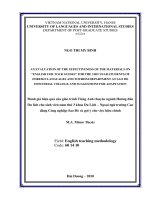An evaluation of the material english for chefs for the first year students in the cooking class at hai phong technological and vocational training school
Bạn đang xem bản rút gọn của tài liệu. Xem và tải ngay bản đầy đủ của tài liệu tại đây (1.25 MB, 74 trang )
VIETNAM NATIONAL UNIVERSITY, HANOI
UNIVERSITY OF LANGUAGES AND INTERNATIONAL STUDIES
FACULTY OF POST-GRADUATE STUDIES
NGUYỄN THỊ NGỌC CHÂU
AN EVALUATION OF THE MATERIAL
“ENGLISH FOR CHEFS”
FOR THE FIRST YEAR STUDENTS IN THE COOKING CLASS
AT HAI PHONG TECHNOLOGICAL AND VOCATIONAL
TRAINING SCHOOL
( Đánh giá giáo trình “ Tiếng Anh chuyên ngành chế biến món ăn” cho học sinh năm thứ
nhất ngành Chế biến món ăn tại trường Trung cấp Nghiệp vụ và Công nghệ Hải Phòng)
M.A. MINOR THESIS
FIELD
: ENGLISH TEACHING METHODOLOGY
CODE
: 60 14 10
SUPERVISOR : PHẠM THỊ HẠNH, M.A.
SUPERVISOR : PHAM THI HANH, M.A.
HA NOI-2010
v
Table of content
Part 1: INTRODUCTION
1. Rationale of the thesis ................................................................................................................ 1
2. Aims of the thesis ...................................................................................................................... 1
3. Significance of the thesis ........................................................................................................... 1
4. Scope of the thesis ..................................................................................................................... 2
5. Design of the thesis .................................................................................................................... 2
Part 2: DEVELOPMENT
Chapter 1: Literature review
1.1. Materials in Language Teaching and Learning ...................................................................... 3
1.1.1. Roles of Materials in Language Teaching and Learning ..................................................... 3
1.1.2. Advantages and Disadvantages of published textbook for Chefs........................................ 3
1.1.3. The Characteristics of Materials of English for Specific Purpose ....................................... 5
1.2. Material evaluation ................................................................................................................. 6
1.2.1. Purposes of Materials Evaluation ........................................................................................ 6
1.2.2. Types of Materials Evaluation ............................................................................................. 7
1.2.3. Models of Materials Evaluation ........................................................................................... 8
1.2.4.Criteria for Materials Evaluation ........................................................................................ 10
1.3. Materials Adaptation............................................................................................................. 11
1.3.1. Why do we adapt the material?.......................................................................................... 11
1.3.2. Levels of material adaptation ............................................................................................. 12
1.4. Summary ............................................................................................................................... 14
vi
Chapter 2: Research methodology
2.1. An overview of current English Teaching and Learning at HPTVTS .................................. 15
2.2. Research methods ................................................................................................................. 16
2.2.1. Research questions ............................................................................................................. 16
2.2.2. Participants......................................................................................................................... 16
2.2.3. Data collection procedure .................................................................................................. 16
2.3. Summary ............................................................................................................................... 17
Chapter 3: Data analysis
3.1. Material versus Course: Aims............................................................................................... 18
3.1.1. Analysis: course versus the material .................................................................................. 18
3.1.2. Survey: Teachers and students’ opinions about the appropriateness of the material in
term of the aims ........................................................................................................................... 19
3.2 The Material versus the Course: Content Requirement ........................................................ 20
3.2.1 Analysis: Course versus the material. ................................................................................. 21
3.2.2. Survey: Teachers and students’ opinions about the appropriateness of the material in
term of the content ....................................................................................................................... 25
3.3. The Material versus the Course: Methodology Requirement .............................................. 32
3.3.1. Analysis: the course versus the material ........................................................................... 32
3.3.2. Survey: Teachers and students’ opinions about the methodology of the material. ........... 36
vii
Chapter 4: Discussion and adaptation
4.1. Discussion on the aim and content requirements of the course in comparison with the
material and the opinions from teachers and students………………………………………...38
4.2. Discussion on the methodology requirements of the course in comparison with the
material and the opinions from teachers and students. ................................................................ 40
4.3. Teacher’s suggestions for the material improvement ........................................................... 40
4.4. Recommendations for material improvements ..................................................................... 41
PART 3: CONCLUSION
1. Summary of previous parts ...................................................................................................... 44
2. Conclusion ............................................................................................................................... 44
3. Limitation and suggestion for further research ........................................................................ 45
References .............................................................................................................................................. 46
Appendixes ............................................................................................................................................... I
Appendix 1 ................................................................................................................................................. I
Appendix 2 ...............................................................................................................................................VI
Appendix 3 ............................................................................................................................................. VII
Appendix 4 ...............................................................................................................................................XI
Appendix 5 .......................................................................................................................................... XVII
Appendix 6 .......................................................................................................................................... XXII
iv
LIST OF ABBREVIATIONS
VNU: VietNam National University
ULIS: University of Language and International Studies
HPTVTS: Hai Phong Technological and Vocational Training School.
1
PART 1: INTRODUCTION
1. Rationale of the thesis
As a key area in English Language Teaching (ELT), the significance of material design and
evaluation has grown steadily. Evaluation is basically a matching process, which concerns
matching learners’ needs to available solutions (Hutchinson & Waters, 1987. p. 97). Low
(1987, p. 21) reminds us that “teachers generally need to screen materials, in order to predict
their suitability for particular classes”. Thus, material evaluation is a decisive way to question
and develop our own ideas as to what is required. Another benefit is through identifying
strengths and weaknesses in coursebooks, optimum use can be made of strong points, and
weaker points can be adapted or substituted from other books (Cunningsworth, 1995, p. 14).
At present, there are not many coursebooks on cooking for students of cooking classes at
vocational schools in Vietnam in general and at my school in particular. At HPTVTS, the
books used to some extent are not really effective for their studies. Moreover, these books can
lack practical information with too much theory and some contents are not suitable with the
objective of the course as well as the demand of students. The material “English for Chefs”
which was issued by Hanoi Publisher has been used as an official coursebook for students of
cooking classes at HPTVTS for 2 years but there hasn’t any evaluation of the effectiveness of
the book in completing the content requirement of the course as well as the aims given.
2. Aims of the thesis
The study is conducted in order to identify:
(1) How appropriate the material is in terms of content, objectives and methodology.
(2) What remedies for changing or adapting should be used to make the material more suitable
with requirement of the course and students’ need.
3. Significance of the thesis
English for Chefs is a compulsory subject of students of cooking classes at HPTVTS as it may
be necessary for their future jobs. At present, “English for Chefs” is being used as the official
coursebook for this subject. However, there has not been any valuation of this book there so
that the author decides to find out how good it is of the current English material used for
2
students of cooking class with the hope of having a good English material for students of
cooking class which helps provide students with certain knowledge of English specializing in
cooking and boost students’ belief in the training quality of school.
4. Scope of the thesis
There are many criteria to evaluate a material such as the audience, the content, the
methodology, the cultural bias, the layout, the authenticity, and so on. In this thesis, the author
aims at the appropriateness of the material to the content requirement, the objective and the
methodology of the course which are based on Hutchinson and Water’s model (1987). The
study is conducted by getting the results from the material analysis and utilizing the survey
method applying on both teachers who have been teaching the material for 2 years and
students who have used this material.
5. Design of the thesis
The thesis consists of three main parts: introduction, development and conclusion
Part one gives an overview of the thesis with the introduction, rationale, aims, scope and
significance of the thesis
Part two includes four chapters in which chapter one is the literature review of the thesis with
the different views about material evaluation, the role of material as well as the material
evaluation. It also points out some ways of evaluating a material with different criteria of
different linguists. Chapter two presents the current teaching and learning English at HPTVTS,
the research method, and data collection procedure of the study. Chapter three presents the
results from the survey and the analysis of the material. Chapter four discusses the findings of
the research and suggestions on material adaptations.
Part three provides the conclusion of the whole study and limitations of the thesis, and
recommends further research.
3
PART 2: DEVELOPMENT.
CHAPTER 1: LITERATURE REVIEW
1.1. Materials in Language Teaching and Learning
1.1.1. Roles of materials in Language Teaching and Learning
Allwright (1990) argues that materials should teach students to learn, that they should be
resource books for ideas and activities for instruction/learning, and that they should give
teachers rationales for what they do. From Allwright's point of view, textbooks are too
inflexible to be used directly as instructional material. O'Neill (1982), in contrast, argues that
materials may be suitable for students' needs, even if they are not designed specifically for
them, that textbooks make it possible for students to review and prepare their lessons that
textbooks are efficient in terms of time and money, and that textbooks can and should allow
for adaptation and improvisation
Materials include textbooks, video and audio tapes, computer software, and visual aids. They
influence the content and the procedures of learning. The choice of deductive vs. inductive
learning, the role of memorization, the use of creativity and problem solving, production vs.
reception, and the order in which materials are presented are all influenced by the materials.
In fact, much of the language teaching that occur today throughout the world could not take
place without the extensive use of commercial textbooks. Hence, how to use and adapt
textbooks is an important part of teacher’s professional knowledge.
1.1.2. Advantages and Disadvantages of published coursebooks
According to Penny Ur (1996), published coursebooks have their own advantages and
disadvantages (The term ‘coursebook’ here means the textbook of which the teacher and
usually each student has a copy, and which is in principle to be followed systematically as the
basis for a language course)
4
Advantages
- Framework: A coursebook provides a clear framework that teacher and learner know where
they are going and what is coming next, so that there is a sense of structure and progress.
- Syllabus: In many places the coursebook serves as syllabus; if it is followed systematically, a
carefully planned and balanced selection of language content will be covered.
- Ready –made texts and tasks: The coursebook provides tasks which are likely to be an
appropriate level for most of the class. This, of course, saves time for the teacher who would
otherwise have to prepare his or her own.
- Economy: A book is the cheapest way of providing learning material for each learner;
alternatives, such as kits, set of photocopied papers or computer software, are likely to be
more expensive relative to the amount of material provided.
- Convenience: A book is a convenient package; it is bound, so that its components stick
together and stay in order; it is light and small enough to carry around easily; it is of a shape
that is easily packed and stacked; it does not depend for its use on hardware or a supply of
electricity.
- Guidance: For teachers who are inexperienced or occasionally unsure of their knowledge of
the language, the coursebook can provide useful guidance and support.
- Autonomy: The learner can use the coursebook to learn new material, review and monitor
progress with some degree of autonomy. A learner without a coursebook is more teacherdependent.
However, though how much the textbooks are well planned, they have their own
disadvantages. So that Penny Ur also gives some drawbacks of textbooks that he means
‘coursebook’
Disadvantages
- Inadequacy: Every class - in fact, every learner - has their own learning needs: no one
coursebook can possibly supply these satisfactorily.
- Irrelevance, lack of interest: The topic dealt with in the coursebook may not necessarily be
relevant or interesting for your class.
5
- Limitation: a coursebook is confining – Its set structure and sequence may inhibit a teacher’s
initiative and creativity, and lead to boredom and lack of motivation on the part of the learners.
- Homogeneity: Coursebooks have their own rationale and chosen teaching/learning approach.
They do not usually cater for the variety of levels of ability and knowledge, or of learning
styles and strategies that exist in most classes.
- Over-easiness: Teachers find it too easy to follow the coursebook uncritically instead of
using their initiative; they may find themselves functioning merely as mediators of its content
instead of as teachers in their own right.
1.1.3. The characteristic of English for Specific Purpose (ESP).
The most important difference between English for Specific Purposes (ESP) and English as
a Second Language (ESL) (also known as general English) lies in the learners and their
purposes for learning English. ESP students are usually adults who already have some
acquaintance with English and are learning the language in order to communicate a set of
professional skills and to perform particular job-related functions. An ESP program is,
therefore, built on an assessment of purposes and needs and the functions for which English is
required.
ESP concentrates more on language in context than on teaching grammar and language
structures. It covers subjects varying from accounting or computer science to tourism and
business management, and the like. The ESP focal point is that English is not taught as a
subject separated from the students' real world (or wishes); instead, it is integrated into a
subject matter area important to the learners.
However, ESL and ESP diverge not only in the nature of the learner, but also in the aim of
instruction. In fact, as a general rule, while in ESL all four language skills, namely listening,
reading, speaking, and writing, are stressed equally, in ESP it is a needs analysis that
determines which language skills are most needed by the students, and the syllabus is designed
accordingly. An ESP program might, for example, emphasize the development of reading
skills in students who are preparing for graduate work in business administration; or it might
6
promote the development of spoken skills in students who are studying English in order to
become tourist guides.
As a matter of fact, ESP combines subject matter and English language teaching. Such a
combination is highly motivating because students are able to apply what they learn in their
English classes to their main field of study, whether it be accounting, business management,
economics, computer science or tourism. Being able to use the vocabulary and structures that
they learn in a meaningful context reinforces what is taught and increases their motivation.
The students' abilities in their subject-matter fields, in turn, improve their ability to acquire
English. Subject-matter knowledge gives them the context they need to understand the English
of the classroom. In the ESP class, students are shown how the subject-matter content is
expressed in English. The teacher can make the most of the students' knowledge of the subject
matter, thus helping them learn English faster.
The term "specific" in ESP refers to the specific purpose for learning English. Students
approach the study of English through a field that is already known and relevant to them. This
means that they are able to use what they learn in the ESP classroom right away in their work
and studies. The ESP approach enhances the relevance of what the students are learning and
enables them to use the English they know to learn even more English, since their interest in
their field will motivate them to interact with speakers and texts.
1.2. Materials evaluation
1.2.1. Purposes of Materials Evaluation
Some of the main purposes of evaluation, the first of which is that students become more fully
involved in the decision making process. They come to understand the goals of the teachers,
and it also gives them the opportunity to reflect upon their own learning and whether their
objectives are being achieved. This helps to break down barriers between students and those in
authority and helps to foster a more student-centered environment. The second aspect of
evaluation is that it should lead to better communication between all those involved in an
educational project. It can involve the recording and exchange of information that can be
7
passed on to other bodies in the form of reports. Third is the improvement in accountability to
both the public and the learners when evaluation information is made available.
Actually, materials, especially authentic materials, play a significant role in foreign language
teaching. They are not simply the everyday tools of the language teachers; they are an
embodiment of the aims and methods of the particular teaching/learning situation. In the
words of Cunningsworth (1995, p. 7), coursebook is “a resource in achieving aims and
objectives that have already been set in terms of learner needs”. Through evaluation, we can
assess whether the coursebook is the most appropriate for the target learners at various levels
and in various teaching settings. What is more, the evaluation process will involve elements of
comparison, especially where existing materials are being challenged by newly produced
materials.
At HPTVTS, the material “English for Chefs” has been used for two years and it has shown
certain advantages and disadvantages, so the author carries out this research with the same
purpose as Cunningsworth’s. This means the study is conducted in order to find out if the
material reaches the aim, objective and method requirements of the course as well students’
needs or not.
1.2.2. Types of Materials Evaluation
Different linguists have their own ways of categorizing the material evaluation. In terms of
when to evaluate a coursebook, Cunningsworth (1995, p. 14) points out that pre-use
evaluation, in-use evaluation and post-use evaluation are engendered, while Robinson
(1991:59) classified materials evaluation into three types: preliminary, formative, and
summative.
- Pre-use evaluation or preliminary tends to be the most difficult kind since there is no actual
experience of using the coursebook.
- In-use evaluation or formative, from another perspective, is a kind of evaluation for
suitability, involving “matching the coursebook against a specific requirement including the
learners’ objectives, the learners’ background, the resources available, etc” (Cunningsworth,
8
1995, p. 14). It allows immediate feedback to be given to both students and teachers, and
revisions and improvements to be made.
- Post-use evaluation or summative refers to an assessment of a textbook’s fitness over a
period of continual use. The outcomes of the course are assessed against the aims and
objectives to show how well the instructional material has been learned. Summative
evaluation is also used to evaluate the overall effectiveness of a learning program. Evaluation
of this kind can be practical in helping to decide whether to use the same textbook on future
occasions. As said above, the material “English for Chefs” has been used at HPTVTS for two
years so that the researcher decides to use post-use evaluation/summative with an aim to find
out whether this material is effective or not and offer further improvement of the material.
1.2.3. Models of Materials Evaluation
There are many different models of material evaluation. Some of commonly adopted models
are suggested by Breen and Candlin’s and Hutchinson & Water (1987).
1.2.3.1. Breen and Candlin’s framework (1987): (in Sheldon 1987, ELT Document 126)
PHASE ONE: Initial questions
I. What do the materials aim to do and what do they contain?
II. What do the materials make your learners do while they are learning?
III. How do the materials expect you to teach the learners in the classroom?
IV. Are the materials the only resource in classroom language learning?
PHASE TWO: Your learners and the materials
I. Are the materials appropriate to your learners’ needs and interests?
II. Are the materials appropriate to your learners’ own approaches to language learning?
III. Are the materials appropriate to the classroom teaching/learning process?
IV. Seven design features of materials for classroom work
V. Discovering learners’ criteria for good materials
.
9
1.2.3.2. McDonough and Shaw’s model (1993)
McDonough and Shaw (1993) provide a flexible two-stage model for the comprehensive
evaluation of course books.
-
External evaluation includes criteria which gives an overview of the organizational
foundation of the course book, ‘as stated explicitly by the author/publisher’ through the
cover, introduction and table of contents statements.
-
In-depth internal investigates the course book, ‘to see how far the materials in question
match up to what the author claims as well as to the aims and objectives of a given
teaching program.”
(McDonough and Shaw 1993: 64).
The final step is overall evaluation. This helps to identify strengths and weaknesses in course
books already used in classes in terms of usability, the generalizability, the adaptability, and
the flexibility.
Apparently, this model is a combination of macro and micro – evaluation method.
1.2.3.3. Hutchinson and Waters’ model ( 1987)
Evaluation by Hutchinson and Waters (1987) is a macro-evaluation. According to them, the
materials evaluation can be divided into four major steps
(1) Defining criteria — On what bases will you judge materials?
(2) Subjective analysis — What realizations of the criteria do you want in your course (e.g.
who are your learners; what language points should be covered)?
(3) Objective analysis—How does the material being evaluated realize the criteria (e.g. who is
the material intended for; how is the content organized within the units)?
(4) Matching—How far does the material match your needs ? (Hutchinson & Waters, 1987, p.
97)
For the purposes of this evaluation, I will follow the model provided by Hutchinson and
Waters (1987), applying pertinent criteria to the coursebook used in my working context. The
model’s procedural format and flexibility will allow me to fully assess the strengths and
weaknesses of my materials. Basing on the research results, good aspect as well as
10
problematic parts of the material can be identified, which may be a reliable ground for further
suggestions on material improvements.
1.2.4 Criteria for Materials Evaluation
Penny Ur provides the following criteria to evaluate a material, as following:
-
Objectives explicitly laid out in an introduction, and implemented in the material
-
Approach educationally and socially acceptable to target community
-
Clear attractive layout; print easy to read
-
Appropriate visual materials available
-
Interesting topics and tasks
-
Varied topics and tasks, so as to provide for different learner levels, learning styles,
interest, so on.
-
Clear instructions
-
Systematic coverage of syllabus
-
Content clearly organized and graded ( sequenced by difficulty)
-
Periodic review and test sections
-
Plenty of authentic language
-
Good pronunciation explanation and practice
-
Good vocabulary explanation and practice
-
Good grammar presentation and practice
-
Fluency practice in four skill
-
Encourages learners to develop own learning strategies and to become independent in
their learning.
-
Adequate guidance for the teacher; not too heavy presentation load
-
Audio cassettes
-
Readily available locally
The criteria suggested by Ur seem to be too much detailed but the framework for evaluating a
coursebook is not given so that it may make difficult for the evaluator to begin his/her
evaluation. With the more comprehensive and more brief content, the evaluating criteria
11
defined by Hutchinson and Waters seem to be more helpful tools to language material
evaluators.
According to Hutchinson and Waters (1987), there are four main criteria for materials
evaluation, they are: the audience, the aims, the content, and the methodology.
-
The audience of the materials: the evaluator should obtain information about and from
learners to find out whether the materials are suitable to the students’ age, knowledge
of English, interest and so on
-
Aims of the materials: the evaluator has to check if the materials match the aims and
objectives of the course.
-
Content of the materials: the evaluator has to check if the materials language points,
maro-skills/micro-skills, and topics suit the learners’ need.
-
Methodology of the materials: the evaluator has to find out if techniques, guidance,
aids provide in the materials satisfy the learners and the teachers of the course.
Comparing the two sets of criteria provided by Ur (1996) and Hutchinson and Waters (1987),
it seems that the Hutchinson and Waters (1987)’s criteria are more practical and helpful for the
evaluators as they provide the clear way how to conduct a study on material evaluation. As a
result, the author decides to choose the criteria of Hutchinson and Waters (1987) as the guide
to see how much “English for Chefs” matches with the aims and the requirement of the
course.
1.3. Materials Adaptation
1.3.1. Why do we adapt the material?
Despite the great effort that textbook writers make to meet the needs of the intended users,
textbooks are subject to adaptation when they are actually used in the classroom. After all,
most commercial textbooks are not written for any particular class. What makes the matter
worse is that sometimes the teachers are compelled to use certain materials, that is, materials
imposed by authorities. In a word, in most ELT cases, teachers have to adapt the materials
they are using if they want their teaching to be more effective and more interesting.
12
Materials adaptation should be based on the results of materials evaluation. Of course different
materials have different potential areas for adaptation. The following are some common
deficiencies of existing ELT materials
-
Fail (unable) to fulfill the goals and objectives specified by national or local syllabuses
or curricula
-
Fail to fulfill the goals and objectives of schools where the materials are used
-
Cannot be finished in the time available
-
Require facilities or equipment or other supporting materials that are not available
-
Not engaging the learners’ personality
-
Detrimental to the learners’ culture
- Not cater for the learners’ interests
McDonough and Shaw (1993:86) have listed more reasons for materials adaptation. The most
important reason is that there is mismatch between what is needed and what is provided by
materials
1.3.2. Levels of material adaptation
Macro adaptation
This is ideally done before the language programme begins. After comparing what is covered
in a textbook and what is required by the syllabus or examination, the teacher may find that
certain areas or even whole units of the book can be omitted, and certain contents need to be
supplemented. Macro adaptation is very important because it helps to avoid waste of time and
energy of the teacher and the students as well. It also helps the teacher to see in advance what
he or she needs to supplement so that he or she can keep an eye on materials that could be
used.
Adapting a unit
This could be reordering the activities, combining activities, omitting activities, rewriting or
supplementing exercise material, etc. Unit adaptation helps to make the classroom teaching
more smooth and cohesive. It also helps the teacher to better fulfill the aims of a unit.
13
Adaptation of specific activities
Occasionally an activity is regarded as valuable, but it is not well-designed or it is not feasible
in a particular class. If the teacher does not want to give up the activity, he or she needs to
adapt it.
Specific adaptation
McDonough Shaw (1993: 86) presented some criteria for adaptation as the following:
- Deleting or omitting: deletion means cutting one or more stages within an activity or
omitting a whole work together. The tasks in the material may be deleted and compensated by
a more suitable one to meet the objectives of the whole.
- Modifying: Modification can be divided into two specific ways: re-writing and re-structuring.
Re-writing refers to the modification of the linguistic contents while re-structuring applies to
the classroom management.
- Simplifying: simplification is a type of modification namely re-writing activity. Many
element of the material can be simplified such as the instruction explanations or even the
visual layout of materials but the text or most reading passages are applied to this technique.
Teachers can simplify the texts with sentence structures, the grammar structures and the
lexical content.
- Reordering: teachers may decide that the order in which the material is presented is not
suitable for their students. They can use the technique of re-ordering to put parts of the course
in different order, adjusting the sequence of presentation within unit, or arrange of different
units in a course book.
- Re-placing: after being evaluated, text or exercise material which is considered ineffective or
inappropriate for whatever reasons may be replaced by a suitable one.
The adaptation technique of McDonough Shaw appears to be detailed. As a result, in this
thesis, the writer will use Shaw’s adaptation technique as guide for adapting any unsuitable
issues in the material “English for Chefs”.
14
1.4. Summary
To sum up, material evaluation can provide teachers a good source of techniques, tell us what
to do as well as what to avoid and consequently help us make optimum use of the existing
materials. For this reason, language teachers should judge the fitness of the coursebook timely.
Based on the evaluation results, we can either replace the coursebook in use to adopt the most
suitable one or to adapt the existing materials. By further adapting coursebooks in use, we can
save a lot of expense and efforts. It is also worth noting that the evaluation process is
particularly helpful for teachers to gain good and useful insights into the nature of the material.
Only in this way, can we respond to learners’ needs at the utmost and maximize the
learning/teaching objectives. Therefore, this chapter can be seen as the theoretical foundation
for the application of the study in chapter three and the improvements in chapter four that
should be made to the coursebook “English for Chefs” for students of the cooking class at
Haiphong Technological and Vocational Training School.
15
CHAPTER 2: RESEARCH METHODOLOGY
2.1. An overview of current English Teaching and Learning at HPTVTS
Hai Phong Technological and Vocational Training School is responsible for training various
vocations such as cooking, accounting, biological technology, and so on. It is a newly built
school so the teaching condition and the teaching equipments are pretty good. The school has
a special room for studying foreign languages. Twenty students in each class is small enough
for learning English efficiently with such modern teaching facilities as computer, projector
and system of speakers in the room. However, the number of reference books for students is
very limited because the school library has not come into use.
Most of non-English major students come from the rural areas of Haiphong. By the time they
enter the HPTVTS, they are all supposed to experience seven years of learning English at
secondary school and high school. However, their English proficiency and language
competence are different; some of them have poor English whereas some others are pretty
good. Moreover, many students at HPTVTS get used to being taught in an inactive way when
they are at secondary and high school where they are not encouraged to raise their voice or
give their own ideas confidently. In an English class, with limited time, only some proficient
students are motivated to follow new methods of teaching and participate actively in groupwork activities and discussions, and so on. Meanwhile, weaker students keep quiet, just sit,
listen and take notes of what the teacher says or writes on the board. They are too shy to speak
in front of the class. They just learn for marks and the examinations, not for the practical use
for their future jobs. This difference in learning styles presents a lot of difficulties for teachers
to plan their lessons and boost students’ interest in learning English In such a teaching context,
teachers have to use both traditional and communicative approaches in their teaching so as to
fulfill the requirements of the course.
16
2.2. Research methods
2.2.1. Research questions
The study aims at answering the two following questions:
1. Does the material “English for Chefs” meet the requirements of the course provided
at HPTVTS in terms of aims, content and methodology?
2. What remedies for changing or adapting should be used to make the material more
suitable with requirement of the course and students’ need?
2.2.2. Participants
As HPTVTS has two cookery classes with twenty students each at elementary level so that all
of them and four English teachers who have been teaching the material “English for Chefs”
for two years are selected as the respondents of the survey research.
2.2.3. Data collection procedure
2.2.3.1. Document analysis.
* The document analysis is divided into two stages in each criterion as follow:
* The analysis of the aim requirements of the course and material
* The analysis of the content requirement of the course and the material in such criteria as:
-
Language points: Vocabulary and Grammar structures and Pronunciation
-
Macro - Skills
-
Micro - skills
-
Text - type
-
Subject matter
-
Layout and design
-
Sequence of content
-
Time allocation for each unit
-
Teaching aids
*The analysis of the methodology requirement of the course and the material in such criteria
as:
-
Kinds of exercises and activities
-
Teaching – learning techniques
17
-
Methodological guidance.
The results of the analysis in terms of aims, content and methodology requirements of the
course (subjective analysis) and those from the “English for Chefs” analysis (objective
analysis) will show how well they are matched with each other, from which, suitable
adaptation is suggested for the material.
2.2.3.2. Questionnaires
The questionnaires were designed based on criteria of Hutchinson and Water’s model (1987)
in order to gather ideas from teachers and students about the material. They were distributed to
teachers and students at the end of the course “English for Chefs” in the second term of the
school year 2009 – 2010.
First of all, sample questionnaires were distributed to a teacher and 5 students to pilot if there
were any misunderstanding questions or not. Then some editions were made to make sure that
no confusing question was used. Lastly, questionnaires were sent to all participants of the
research.
The questionnaires were divided into four parts:
Part I: Focuses on the opinions of teachers and students about the aim of the material in
relation to the aim of the course. (Questions 1- 7)
Part II: Investigates their opinions about the content of the material (Question 8 – 15)
Part III: Finds out their opinions about the methodology (Question 16 – 22)
Part IV: Seeks for teachers and students’ suggestions for the improvement of the material
(Questions 23 – 30)
2.3. Summary
This chapter has provided an overview of the current English teaching and learning context at
HPTVTS. The participants who joined the research are English teachers and forty students of
two cooking classes who are teaching and learning the material “English for Chefs”.
Questionnaires and material analysis in terms of aim, content and methodology are
instruments to carry out the research to find out the answers of the two given research
questions.
18
CHAPTER 3: DATA ANALYSIS
First of all, the study is begun by comparing the course objectives with the material, then, the
results from teachers and students about the same subjects are presented.
3.1. Material versus Course: Aims
3.1.1. Analysis: course versus the material
Course objectives
Material
1. Basic grammar structure: simple
This
section
is
divided
into
three
stages:
present tense and past simple tense; presentation, language study and practice.
comparatives and superlatives; the - In the presentation stage: dialogues and questions
passive voice; model verbs; some with the topic relating to cooking, food or restaurant
structures:
infinitive
clause
and in which the new grammar structures are given.
phrases of purpose, imperative forms,
- The second stage: rules and usages of the given
making suggestions, adverbs, and grammatical items.
expression of like and dislike
- The third stage: exercises for practicing
2. Special vocabulary in cooking, - Wide ranges of special terms in cooking as well as
restaurant
the vocabulary of food.
- Different activities such as matching, crossword
games, filling… to drill the new words.
3.
The
opportunity
pronunciation
focusing
to
on
improve - Stress patterns, the word – linking, reduced sound
linked appear.
sounds, reduced form, stress, word - No explanation and lack of exercises for practicing.
linking
4.
The
opportunity
to
practice - Different kinds of activities such as individual, pair
speaking skill through the different – work, group-work in describing and giving
19
tasks in various situations in cooking, instructions how to cook, introducing food and
restaurant
cooking recipes, conversation in the kitchen and at
the restaurant.
5. The opportunity to improve reading - Reading passages about cooking, food, traditional
skill through the reading passages dishes in Europe, Asia and Vietnam with tasks for
about cooking, food, and restaurant
practicing.
- Some passages do not have tasks for practicing.
6.
The
listening
opportunity
skill
to
through
practice - Various kinds of exercises relating to the topic of
different cooking or restaurant.
listening tasks about cooking, food, - Not enough exercises for practicing.
restaurant.
7. The opportunity to practice and - Write simple sentences, passages, letters, cooking
improve writing skill with focus on recipes.
sentences, note taking, instruction in - Lack of detail instruction of writing a letter or
cooking and paragraphs
sample of a letter.
Table 3.1: The appropriateness of the Material to the Aims of the Course
3.1.2. Survey: Teachers and students’ opinions about the appropriateness of the material
in term of the aims
Teacher
Does the material provide students with
Students
Yes
Partly
Not
Yes
Partly
Not
1. develop basic grammatical points?
100%
0%
0%
100%
0%
0%
2. widen vocabulary of cooking, kinds of food,
100%
0%
0%
95%
5%
0%
opportunity to …?
kitchens and restaurants, ect…?
20
3. improve their pronunciation, linked sounds,
0%
25%
75%
10%
23%
67%
4. improve speaking skill?
75%
25%
0%
87%
13%
0%
5. improve reading skill ?
50%
50%
0%
67,5%
24,5%
8%
6. improve listening skill?
50%
50%
0%
62%
20%
18%
7. improve writing skill?
75%
25%
0%
78%
10%
12%
stress, reduced forms and intonation?
Table 3.2: Teachers and students’ opinions about the appropriateness of the material in term
of the aims (Q 1 – 7)
The results presented in table 3.2 revealed that all teachers and nearly most of students (95%)
agreed that the material provided adequate amount of basic grammar and widened the
vocabulary of cooking, e.g. some common kinds of food and words used in kitchens and
restaurants. In contrast, 75% teachers and 67% students reckoned that the material had poor
help in improving students’ pronunciation, linked sounds, stress, reduced forms and
intonation. This result fitted with the document analysis of the pronunciation part because
there was a lack of practice exercises for each pronunciation pattern in the material. However,
75% and 87% of teachers and students thought the material helped improve speaking skill and
a large number of teachers and students agreed that the material also provided good chances to
improve writing skill. Having the similar result with speaking and writing, 75% of the teachers
and 62% of the students affirmed that students could acquire and improve listening skill
through practice exercises while 25% of teachers and 20% of students just agreed that the
material was partly suitable for improving this skill. Besides, reading skill seemed not really to
fulfill the aim of the course as half of teachers and about one third of students agreed with this
idea.
3.2 The Material versus the Course: Content Requirement
The comparison between the content requirements and the content of the material is
conducted, next, teachers and students’ ideas about that are presented. These ways will help
find out how appropriate the material is with the course content requirements.

